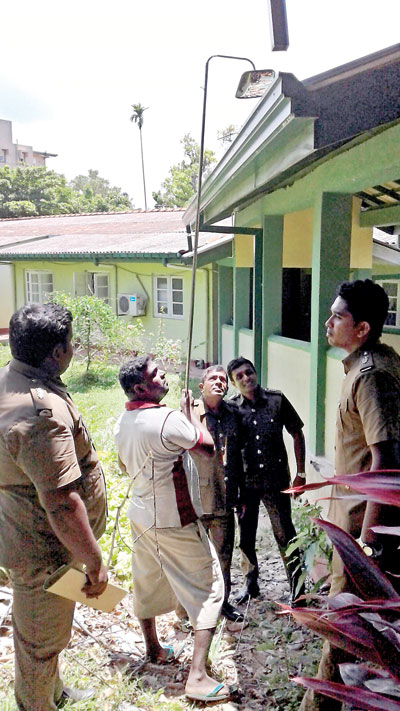News
293 dengue victims every day, failing health officials overwhelmed

PHIs inspecting the district hospital at Beruwala. -Pic by Sarath Siriwardene
Not unexpectedly, the dengue peak season has arrived this month to coincide with the Southwest monsoon, which lasts until September, and the 92 deaths so far this year is set to surpass 97 people who perished last year.
Every day 293 Sri Lankans were infected with dengue from January to May.
Many who die are below 30 and most are children below 15 years of age.
For years now the Ministry of Health and its affiliates as well as municipal health officials have failed miserably to rein in the Aedes aegypti mosquito, the main carrier of the deadly viral disease. Hospitals are overflowing.
Health officials admit being overwhelmed and complain there is not enough workers for anti-mosquito campaigns. They are unable to sustain vector-control campaigns.
In the first five months, 44,000 cases have been reported, compared with 47,502 cases in all of 2014. This amounts to 293 infections every day. Every day 82 people became infected in the past 14 days of this month alone, adding up to 1,500 cases.
The number of cases in the first four months of last year was 16,661.
March was the worst month this year when 13,373 cases were reported, according to the Epidemiology Unit of the Ministry of Health, under Minister Rajitha Senaratne.
In 2016, dengue cases nearly doubled to 50,519 compared with 2015 when 29,777 were infected.
Most dengue cases are in the Colombo district with 9,278 infected in the past four months followed by Gampaha district with 5,485. Trincomalee, Kurunegala, Batticaloa and Kalutara districts also reported a large number of cases.
According to the Ministry of Health, workplace related mosquito-breeding sites had increased from 38 per cent in 2016 to 40 per cent this year while the breeding in school premises had risen to 38 per cent this year from 32 per cent last year.
The Epidemiology Unit will carry out a dengue breeding source reduction campaign on 18th and 19th of this month in 11 high risk districts: Colombo, Gampaha, Kalmunai, Kandy, Kalutara, Galle, Matara, Kurunegala, Kegalle, Jaffna, and Batticaloa, involving 1,800 teams, Dr. Preshila Samaraweera, Consultant Community Physician in the Epidemiology Unit, said.
Construction sites, schools, government institutions (mainly hospitals), religious places and households are suspected to be main dengue mosquito breeding sites.
Dr. Samaraweera also said that, in the Colombo district, out of 15 areas under the medical officers of health, 11 are high risk: Dehiwala, Ratmalana, Moratuwa, Maharagama, Mahara, Kaduwela, Kolonnawa, Boralesga-muwa, Battaramulla, Hanwella, and Homagama.
“Local governments should make sure that dumping sites do not end up being major breeding spots. Dengue control is a multisectoral approach and it is difficult for the Health Ministry alone to handle.”
Empty jars, pots, buckets, flower vases, water tanks, discarded bottles and containers, tyres, air conditioners, water coolers and refrigerator trays are known breeding sites. Containers, tanks or barrels should be drained or cleaned at weekly intervals, health officials say.
“Another reason for the rise in the [dengue] figures might have been the fact that we couldn’t do the case-based fogging to a 100 percent, because of the high case load,” Dr. Samaraweera said.
She added that usually when a case is notified, the area needs to be sprayed with insecticide within three days, but when the number of cases is high this is difficult, because of a shortage of staff.
Hospitals have filled up to capacity. The number of patients in the Colombo district at present: Infectious Disease Hospital, 250; Jayawardenepura Base hospital, 150; Kalubowila teaching hospital, 140; Kurunegala hospital 100 and the National Hospital Colombo, 90. An average of 20 patients is being admitted to the hospital every day. 
The Director of National Hospital Colombo, Dr. Anil Jasinghe said two thirds of the dengue victims were below the age of 30 and, of them, a majority are children below the age of 15.
In March, there were not enough beds. “We had to keep three patients in one bed,” Dr Jasinghe said.
Director (acting) at Kurunegala Hospital, Dr. Chandana Kendangamuwa, said temporary wards have been set up and more doctors and nurses have been deployed to treat dengue patients.
In Sri Lanka, prevention of dengue is left largely to households, while the government offers testing and hospital beds.
Dr. Kendangamuwa, said: “The intervention by Government through a strategy of prevention is cheaper compared with the state paying for the tests and hospitalisation.’’
Dr. R. M Ratnayake, Kandy hospital director, said that fogging is done in the hospital premises every week. To date, there are almost 50 patients.
He warns against self-medication.
“Avoid taking over-the-counter drugs,’’ he said adding that, while paracetamol in the recommend dosage is fine for the first 48 hours, other drugs should not be taken as they could lead to complications like gastritis and bleeding.
He also said entomologists should be deployed in high-risk areas to collect mosquito larvae and conduct tests and assist in research.
| SRI LANKA DENGUE BLAMED ON ASIA While tens of thousands of people infected with the killer dengue virus pile up in Sri Lanka, the Prime Minister Ranil Wickremesinghe explained the failure to reduce deaths and cases by telling parliament in March that the spread of dengue was part of health crises in Asia. March was the worst month this year in Sri Lanka when 13,373 dengue cases were reported. He said: “Diseases such as fever and even bird flu are spreading in Asia, and millions of poultry are being destroyed in South Korea today. And the spread of diseases in Sri Lanka may be a part of this crisis.’’ He made the remarks in response to a question by an opposition lawmaker. |

